Have you ever landed on a website, start reading and feel like buying whatever they’re selling?
It’s so well written that you can’t help but pull out your credit card.
The copy has managed to convince you that what you’ve got before your eyes is precisely what you need and that you need it NOW.
That website is surely written by a copywriter who knows how to apply the 4 Us.
Or at least 3 of them.
The 4 Us make your copy more persuasive and push prospects to keep reading and take action.
First because they attract their attention and second because they increase their urge to get what they don’t have yet.
Once you understand these 4 elements you’ll start recognising them in all good pieces of copy and you’ll be able to apply them when writing your own copy.
The 4 Us are taught in the best copywriting schools and no copywriter can afford to do without them.
These are:
Ultra-specific, useful, urgent and unique.
Let’s look at each of them in detail so you can learn how to use them to elevate your copy.
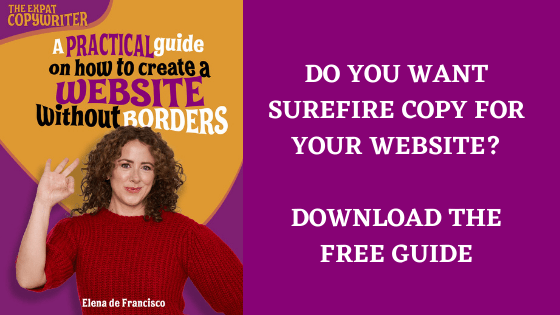
Ultra-specific
I insist on this all the time.
If you’ve read other of my articles, you’ll know that I hammer on this a lot, but it’s because ultra-specificity is what will make your copy interesting and compelling.
If people don’t stop to read (or listen, if it’s a video) what you have to say, you won’t sell anything, will you?
For a piece of copy to be interesting it must be ultra-specific.
Generalities won’t work because we don’t retain them in our memory, nor do they help us to picture in our minds what we’re being told.
To be ultra-specific, details are very important.
The world is made of details and these details are what people will notice and remember.
When selling online, putting an image in the reader’s mind is super important, especially when selling something immaterial.
A design course, a cleaning service, a facial massage, an accounting software etc.
Prospects cannot immediately see what we’re selling.
It’s not a jumper but something more abstract that doesn’t appeal directly to the eyes.
And therefore we need to paint a clear picture in the reader’s mind of what it’ll be like to enjoy all the benefits of that massage or software.
The 4 Us that will make your copy work 11x better. #copywriting #ads #socialmedia Share on XIf you want them to picture it easily, you must be ultra-specific and bring up the details.
In the book Made to Stick written by the Heath brothers – which I highly recommend – they explain why some stories stay in the collective imagination and others don’t. They also give many examples.
Instead of telling you one of those stories, I’m going to give you an example closer to me the Heath brothers don’t talk about.
What I’m about to tell you took place a long time ago but I still remember it.
In the 1990s there was a programme on Spanish television called Sorpresa, Sorpresa (Surprise, Surprise) and as the title implies, it was about giving big surprises to people devised by family and friends.
In all of these surprises there was a celebrity involved.
Basically, the programme was about your mother, boyfriend or friend contacting the programme because they knew you loved Enrique Iglesias and then the programme would organise a funny situation to surprise you and have you meet Enrique Iglesias in person.
The Spice Girls, Back Street Boys, Shakira and other celebrities in the limelight at the time, had been on the programme.
So you can imagine what a huge audience the program had.
Then one day in February 1999, a story began to spread like wildfire.
I was still living in Spain at the time and I remember that it was a friend of mine who came to tell me this:
Last night on Surprise Surprise they wanted to surprise a girl with Ricky Martin so they hid him in a closet at the girl’s home. There were hidden cameras around the apartment to film the girl’s reaction when she opened the closet and saw him there. The girl arrived home, went to her room and got undressed. Then she opened a can of foie gras (there were other versions with jam and Nutella) and smeared it on her private parts. Then she called her little dog that was called Ricky! and he started licking it… People went nuts and they cut the emission and went back to the studio and Concha Velasco (the host) was horrified and announced they were going to the intermission.
There were lots of people who assured to have watched it but it was a tremendous hoax. It never happened!
Why did people believe it and why is the story still remembered today?
Because it was full of details.
Ricky Martin in the closet waiting to come out, the girl undressing in her room, the jam, the doggy called Ricky…
The details were modified as the story passed from mouth to mouth, and more details were added or changed, but it was those details that made the story entertaining and credible.
The 4 Us that will make your copy work 11x better. The 4 Us that will make your copy work 11x better. #copywriting #ads #socialmedia Share on XThe takeaway from this story
Add details to your copy and it’ll be more entertaining, memorable and credible.
Don’t be afraid details will make your copy too long. Those details are what will make people stop scrolling and pay attention.
How to apply ultra-specificity.
When talking about people
One specific person’s story is more compelling than hundreds. Talk about one of your customers or about your own experience. Rather than saying “Everybody experienced X”, say “Sarah experienced X” and detail that person’s experience.
When talking about places
A headline written by Nick O’Connor, one of my mentors, went:
“What happened in Room 301 at Columbia University?”
It was a way of appealing to people’s curiosity so he could bring them to read his sales letter with which he was selling a financial product. What happened in that room was that several future millionaires studied there and in his letter, he linked this curious fact with the rest of the copy.
Saying Room 301 at Columbia University generates more curiosity than just saying Columbia University, or Columbia, or the US.
When talking about time
Especially when you talk about the production process, give details about the time it takes to make that product.
“This dress takes 52 hours to embroidery by hand”.
Or you can create expectation and curiosity by giving an exact time when an event will take place.
“Tomorrow at 18.45 something will happen that can change the course of the world economy”.
When talking about objects
Don’t spare details of the materials. How is it made and where, where the materials come from, and so on. These details may differentiate you from your competition or justify a higher price.
“The cotton this shirt is made of has been hand-picked in the fields of Urtala, a village in Pakistan, by a women’s cooperative. This cotton hasn’t been treated with nasty chemicals. Instead, we use natural pigments of such and such origin”.
So when doing your research ask:
- When?
- How?
- Who?
- For how long?
- How far?
Useful
People are quite selfish.
Most of the time we’ll only pay attention if we think there’s something in there for us.
If your prospect thinks what you’re saying could be useful to him, he’ll listen.
But, when is something useful?
Something is useful when it offers a solution to a problem.
When you can empathise with your buyer persona’s problems, you attract their attention because they feel related.
The reader or the person watching the video thinks “this interests me because it perfectly describes the problem I want to solve”.
The solution to your prospects’ problem can be explicit or implicit in your headline or introduction.
Let me explain it.
An explicit benefit would be a headline like this:
“Discover how this hearing aid will help you hear like you used to”.
And an implicit benefit would be for example this one:
“Prevent nasty arguments with your children”
The prospect will no longer have arguments with his children because they won’t have to shout when talking to him.
The second headline is more unusual and nudges people to read on because it triggers their curiosity.
That’s why it’s better to make the benefit of your product implicit.
This is also called “getting the benefit of the benefit”, which I talk about in more detail in this article about how to create original ideas for your social media ads.
But what happens when your product doesn’t solve a problem?
Suppose you’re selling something that doesn’t offer a clear solution to a problem, such as an ornament, clothing or make-up. In that case, you’ll need to concentrate more on making your headline and introduction ultra-specific and unique.
Although in reality everything has a use and solves a problem or desire.
A garment or a piece of jewellery satisfies the desire for status and sex appeal.
Glenn Fisher, in one of his master classes on The Fix (the copywriting network I belong to), gives this example of a headline that doesn’t contain any useful elements but can work very well because it piques our curiosity:
“Elon Musk’s nightmare”
It’s a great headline because it makes you want to know what Musk’s nightmare will be.
But Glenn improves it by adding usefulness:
“Elon Musk’s nightmare and 4 other investment mistakes that can help you save your portfolio”
Yes, the headline is longer, so what?
Don’t trust the greatest untruth in advertising: the shorter the copy the better.
Feel free to add whatever it’s needed to make your copy more compelling.
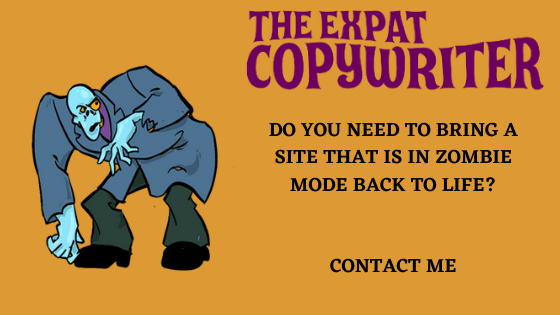
Urgent
People are quite lazy.
“I’ll do it tomorrow” “I don’t need it right now” “That needs a lot of energy”.
But you know how dangerous this is.
If a prospect abandons your sales page or doesn’t watch your video, you won’t be able to convince them to buy from you.
That’s why you should give them urgent reasons to stop scrolling and click on your link now.
Not tomorrow or in a while.
And for that, you must add urgency to your copy.
You add urgency when you convince your prospects they need to pay attention now, because the sooner they do, the sooner they’ll enjoy all those benefits.
It isn’t just about creating special offers for a limited period of time – which, yes, works very well – but about learning other ways to add urgency.
And that’s what we’ll see next.
The 4 Us that will make your copy work 11x better. #copywriting #ads #socialmedia Share on XWays to add urgency to your sales copy
With an approaching date
Dates work really well for financial products, software or courses.
Example:
“On the 8th June, the government will pass a new law that could change forever the way we use banks”.
To apply this way of adding urgency, look for dates when something is going to happen.
It doesn’t have to be drastic, you’ll make it important in the body of the copy.
It can be a summit, the publication of business results, holiday periods, anniversaries, policy changes, etc.
The point is that these dates can trigger an important event in your prospect’s life so they’ll feel the urgency to read it and take action.
With a certain time in the day
Examples:
“Before you go out to lunch this Friday, set aside 2 minutes to get 30, 50 or even 130 € tax-free”.
To add urgency in this way use specific everyday events:
“Before brushing your teeth tonight, take 3 minutes to do this to prevent your teeth from losing their natural enamel”.
“Before you go to work tomorrow, do X”.
With this type of headline, you’re giving them precise instructions on how and when to do something to get a specific result.
The 4 Us that will make your copy work 11x better. #copywriting #ads #socialmedia Share on XWith scarcity
This way of adding urgency is more common but just as valid.
When your prospect knows the product won’t be available forever, they’ll act quicker.
Take the Vinted app as an example.
Vinted is a platform where people buy and sell second-hand clothes.
When you see the shirt you just liked has been also liked by 10 other people, you feel the pressure to buy it before someone else does it.
And that’s why Vinted is so successful.
As we mentioned earlier, special prices for a limited period of time also work well here.
But be careful! If you use this technique, don’t forget to let your prospects know when the special price is over.
And don’t offer it at that special price anymore, otherwise, they won’t believe you the next time you launch a limited offer.
The 4 Us that will make your copy work 11x better. #copywriting #ads #socialmedia Share on XWith implied urgency
Agora is a company that sells financial products. Glenn Fisher, one of my mentors at The Fix, worked there for over 10 years and wrote spectacular sales letters for them.
One of those letters said: “Tell us where you want us to send your £500 cheque”.
If you receive an email like this you’ll open it for sure.
Urgency is implicit in this headline.
It’s not something that will end but people will want to get that cheque ASAP, because it’s something too good to ignore.
This promotion went on adding a specific date “On 10th January at 9 a.m. I will send you your cheque….”.
It was an offer for Agora customers who had already bought a financial product. They were offered to buy all the other products at a reduced price so they’d get their money back for the product they had already bought. (Upselling).
But be careful, adding urgency for the sake of adding urgency won’t work.
Sometimes it won’t be necessary or maybe you don’t see how to do it.
But try always to spend some time thinking about what form of urgency you could add to your sales copy.
You can also add some degree of implicit urgency when you emphasise your prospect’s pain points.
Pain points are all those emotions, setbacks or problems arising from their current situation that your product solves.
“Welcome to the club of those who sleep soundly without money worries”.
If you get this part right, your prospect will feel the urgency to solve her problems. Especially if you have included the other 3 Us.
And now let’s look at the fourth and final U.
The 4 Us that will make your copy work 11x better. #copywriting #ads #socialmedia Share on XUnique
People aren’t only selfish and lazy (I’m not being very kind to Humanity, am I?) but also bored with everything.
We spend hours scrolling down on our phones in zombie mode.
Scrolling and yawning as we read and listen to the same arguments, the same inspirational phrases (that no longer inspire anything), the same repetitive stuff…
But when a business knows how to do things differently, that’s when we wake up from our lethargy and start paying attention.
What makes something unique?
The first thing that comes to mind is that something is unique when it’s completely new, so it didn’t exist before.
But this is very difficult.
It only happens with cutting-edge technology like when the first iPhone came out.
So there’s only one way left to make your product unique, and that’s to sell it in a completely new way.
A different, more original way.
Let’s see this in detail.
Something is unique when it surprises us because we didn’t expect it.
Or when something is unclassifiable and therefore cannot be quickly dismissed with the kind of thinking: “that’s yet another online course…” or ” another miracle diet, yeah, whatever…”.
That’s why when most brands follow the same copywriting techniques, with formulas, headlines and promises already seen a thousand times, their campaigns flop.
And the funny thing is that they’re shocked when this happens!
So how do you make your copy unique?
You should always aim at making people stop in their tracks and read/listen to something different and interesting.
And to find that interesting and original thing to tell your prospects, you have to study every detail of your product or service and think about your prospects’ lives until something unusual comes up.
This is what you need to look out for:
Find out what hasn’t been said before
There’s always a different angle you can take on an issue or an ingredient that no other brand mentions or gives importance to.
Claude Hopkins already realised this in the early days of the last century when he created an ad for Schlitz beer that catapulted the brand to the top, being a record seller for years in the U.S.
And all thanks to the way he presented the beer, in a totally “new” way. Something that wasn’t really unique but that only Schlitz beer talked about.
Let me explain.
At that time all beers in the market claimed to be very pure.
Hopkins did a thorough research on how Schlitz beer was made and realised that the purity was the result of careful processing.
All the beers went through a similar process BUT none of them talked about it.
So Hopkins had a light bulb go off and decided to write an ad dedicated to the Schlitz brewing process.
This ad summarised the scrupulous process the grains went through, from their careful selection to the number of months the beer was left to ferment in barrels to obtain its unique flavour.
He talked about how Schlitz beer was purified in glass rooms with filtered air.
How it was left in casks for months in refrigerated rooms so the beer wouldn’t cause bile disorders as ordinary beers did.
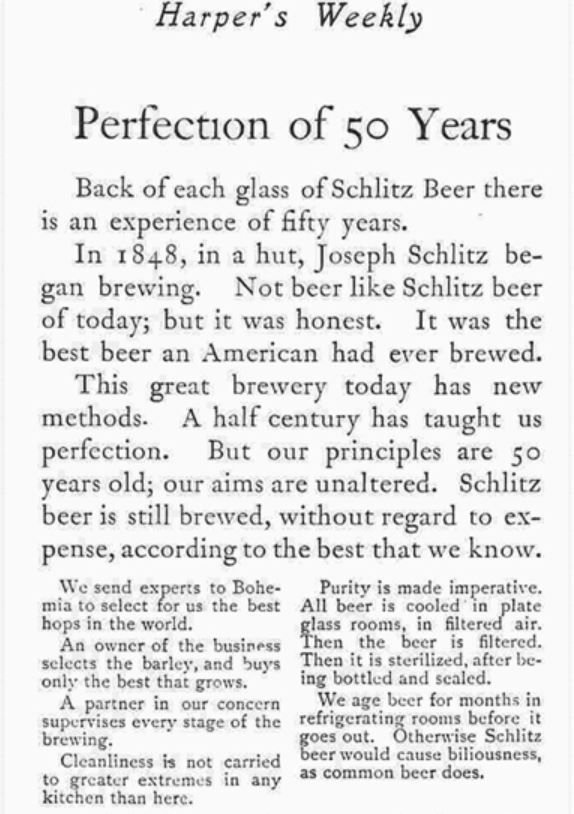
And so he gave his product a superior and desirable aura.
The other beers, although they went through very similar brewing processes, had never talked about it, and even when they started copying Hopkins’ ads it was too late, he had been the first one and Schlitz beer remained the best-selling beer for years.
The 4 Us that will make your copy work 11x better. #copywriting #ads #socialmedia Share on XName a flaw or drawback of your product or service
It sounds counterproductive: “why should I say to my prospects that there’s something negative about my product?”
But trust me, it can earn you points if you do it right.
You see, several studies show that mentioning a flaw in your sales copy creates the perception that your brand is honest and trustworthy.
And then you’ll be more persuasive when you list the benefits of your product.
Let’s look at several examples of this.
Canadian cough syrup Bukcley’s has spent years saying how awful it tastes.
Some of their ad headlines go like: “Our biggest bottle is 200ml. Bigger than that would be cruel” or “We are committed to making every new bottle of Bukcley’s taste as bad as the last”.
Their tagline is always the same: “It tastes awful. And it works.”
With the first sentence, they give more credibility to the second. “And it works”.
Moreover, proclaiming that it tastes horrible makes them unique and their ads are attention-grabbing because they are unusual.
There’s even a challenge implied:
“Let’s see if you dare to try it”.
This tactic has worked wonders in making their product unique.
Volkswagen used this same tactic when introducing the Beetle to the American market.
Knowing the Beetle was very small compared to the average American car, they decided to turn this shortcoming into an advantage.
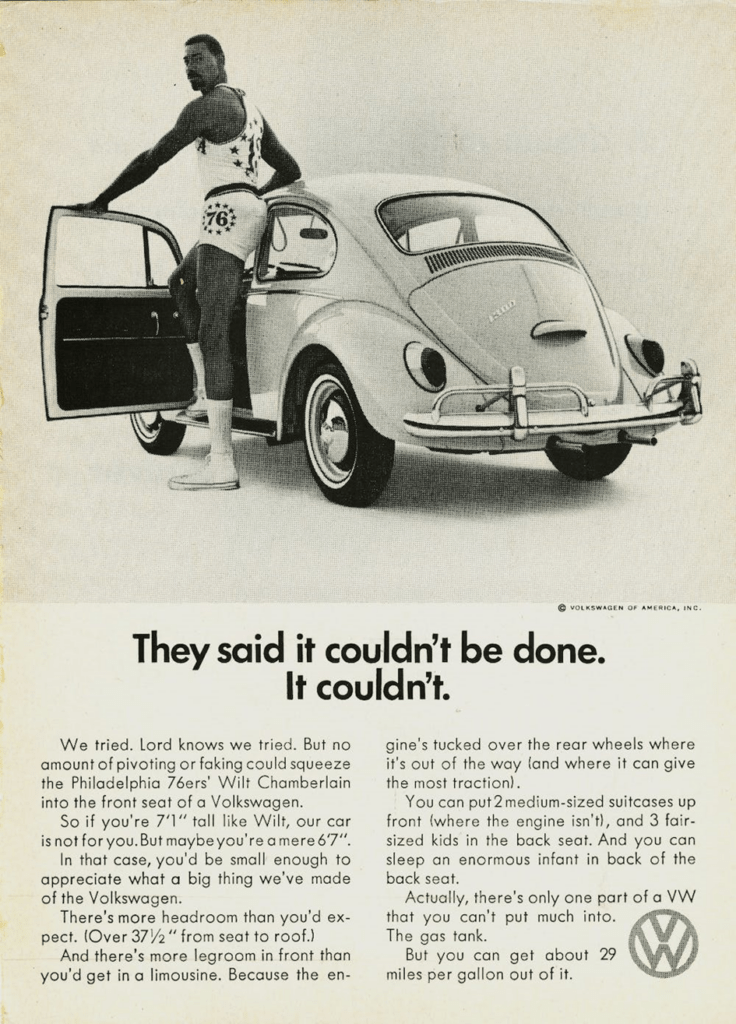
Try to think differently
If you want your product or service to be unique you should try to think differently.
For example, imagining someone else is talking.
Just think, what title would Tarantino give this ad? And Wes Anderson?
Or how would Lisa Simpson describe the benefits of this product?
Try to stay away from what everyone else is doing.
If your competition is trying to be funny, try to sound serious.
If your competition is too conservative, try to be more approachable and easygoing.
Only by being unique will your brand stand out in a saturated market.
To sum up
We live in a world saturated with brands thanks to social media.
If you want to attract attention and get people to listen to you, try to make your videos, posts and ads:
- Ultra-specific, so people get a clear picture in their minds
- Useful, so people pay attention because they sense they’ll get something out of it
- Urgent, so people don’t procrastinate and pay attention right now
- Unique, so people see something different in your brand
I hope this copy class has helped you to improve your sales copy.
The 4 Us are your allies to become more persuasive.
Use them!
The 4 Us that will make your copy work 11x better. #copywriting #ads #socialmedia Share on X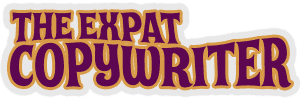
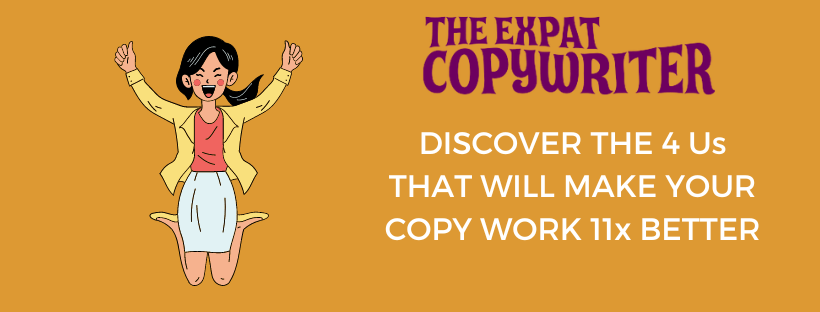
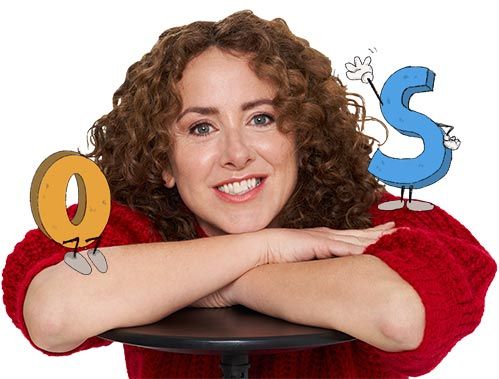
These are really helpful tips! Readers like to know right away what’s in it for them and being ultra-specific in your copy makes that easier for them. Using scarcity also works effectively.
Hi Lux! Thanks for passing by and leaving your comment. I’m really happy you found these tips useful. The 4 Us are a great guide to have at hand when writing copy and making sure it is ultra-especific, unique, useful and urgent.
See you around!
This article on the 4 U’s was really helpful.